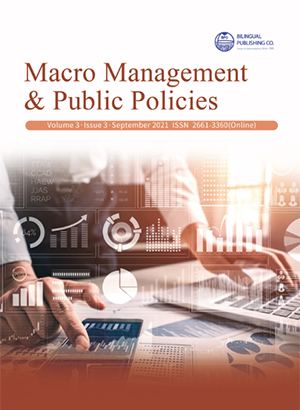-
1918
-
1457
-
1091
-
942
-
824
How does Street Vending Economy Help Rural to Urban Migrants Integrate into Cities?
DOI:
https://doi.org/10.30564/mmpp.v3i3.3599Abstract
Street vending is a form of informal economy. The main participants of street vending economy consist of exploited workers, rural-urban migrants who are in low level of socioeconomic households, common workers, and some individual households. Most of the studies and articles have explored how to regulate the street vending economy and how to facilitate the relationship between vendors and city authorities, but the important constitute of street vending economies, rural migrants, has received little attention from scholars and there is little research about it. What role does street vending economy play in the lives of this segment of this population which itself faces a number of challenges in migrating and integrating into the city? We have found out that street vending functions as a platform which helps these people to better integrate into the cities. Through desktop research and case studies, this paper explores how street vending economy helps rural to urban migrants integrate into the city from four perspectives: identity integration, integrating in economic level, integrating in social level, and females' empowerment.
Keywords:
Street vending economy, Rural to urban migrants, IntegrationReferences
[1] Liu, L.L., Liu, C.S. & Shi, B., (2014). Externality analysis of mobile street vendors and their management policies: a case study of Beijing. Beijing City University. 5, 79-83.
[2] Qi, C.J.(2019). Invisible “Soil”: A study on the social relations of H night market vendors in Yinchuan. Ningxia University.
[3] Cao, G., Li, M., Ma, Y., & Tao, R. (2015). Self-employment and intention of permanent urban settlement: Evidence from a survey of migrants in China’s four major un banising areas. Urban Studies, 52(4), 639-664.
[4] Fan, C.C., (2002). The elite, the natives, and the outsiders: Migration and labor market segmentation in urban China. Annals of The American Geographers. 92(1): 103-124. DOI: https://doi.org/10.1111/1467-8306.00282
[5] Huang, Y.Q. & Jiang, L.W., (2009). Housing inequality in transitional Beijing. International Journal of Urban and Regional Research. 33(4): 936-956. DOI: https://doi.org/10.1111/j.1468-2427.2009.00890.x
[6] Wang, F.L., (2004). Reformed migration control and new targeted people: China’s Hukou system in the 2000s. The China Quarterly(London). 177(177), 115- 132. DOI: https://doi.org/10.1017/S0305741004000074
[7] Chan, K.W. & Zhang, L., (1999). The Hukou System and Rural-Urban Migration in China: Processes and Changes. The China Quarterly. 160(160), 818-855. DOI: https://doi.org/10.1017/S0305741000001351
[8] Business Week (2012) China may finally let its people move more freely. Business Week, 15 March.
[9] Light, I. (1972). Ethnic enterprise in America; business and welfare among Chinese, Japanese, and blacks, Berkeley: University of California Press.
[10] Chen, Y. & Liu, C. Y., (2018). Self-employed migrants and their entrepreneurial space in megacities: a beijing farmers’ market. Habitat International. 83, 125-134. DOI: https://doi.org/10.1016/j.habitatint.2018.11.009
[11] Zuo. C., (2018). Semi-integration: A Study on the Urban integration of street vendors -- a case study of Zhongshan Road, Hengyang City. Central China Normal University. Retrieved from: https://www.vzkoo.com/document/c687681c38a72bff895cbea997d95f9c.html?a=1&keyword=2020%E5%B9%B4%E4%B8%AD%E5%9B%BD%E5%9C%B0%E6%91%8A%E7%BB%8F%E6%B5%8E%E8%A1%8C%E4%B8%9A%E7%A0%94%E7%A9%B6%E6%8A%A5%E5%91%8A
[12] Yuan, T., (2019). A study on multi-department space management model of street vendors in Changsha. Hunan University.
[13] Zeng, S.F.& Liu, Q.Y., (2019). Cultural “semi-integration” : An analysis of the current situation and Countermeasures of urban cultural integration of migrant workers. The Border Economy and Culture. 08, 64-66. DOI: https://doi.org/10.3969/j.issn.1672-5409.2019.08.020
[14] Forward Industry Research Institute.(2020). Forward Industry Research Institute. 2020 China street vending economy industry research report.
[15] Hwang, K., (1987). Face and favor: the Chinese power game. American Journal of Sociology. 92(4), 944-974. DOI: https://doi.org/10.1086/228588
[16] Wu, W.P., (2006). Migrant housing in urban China: Choices and constraints. Urban affairs review (Thousand Oaks, Calif.). 38 (1), 90-119. DOI: https://doi.org/10.1177/107808702401097817
[17] Mouw, T., (2002). Racial differences in the effects of job contacts: conflicting evidence from cross-sectional and longitudinal data. Social Science Research. 31, 511-538. DOI: https://doi.org/10.1016/S0049-089X(02)00020-0
[18] International Labour Organization (ILO), (2018). Women and men in the informal economy: A statistical picture. International Labour Organization. Retrieved from: https://www.wiego.org/sites/default/files/publications/files/Women%20and%20Men%20in%20the%20Informal%20Economy%203rd%20Edition%202018.pdf
[19] Woman in Informal Employment Globalizing and Organizing.(2021). Women’s Economic Empowerment. Retrieved from: https://www.wiego.org/our-work-impact/themes/womens-economic-empowerment
[20] Ryanne F., Werner B., (2016). Migrant Street Vendors in Urban China and the Social Production of Public Space. Population space and place, 22 (2),158-169. DOI: https://doi.org/10.1002/psp.1892
[21] Dai, N., Zhong, T.Y.,& Scott, S., (2019). From Overt Opposition to Covert Cooperation: Governance of Street Food Vending in Nanjing, China. Urban forum (Johannesburg), 30 (4), 499-518. DOI: https://doi.org/10.1007/s12132-019-09367-3
[22] Bell, J.S.& Loukaitou-Sideris, A., (2014). Sidewalk Informality: An Examination of Street Vending Regulation in China. International planning studies, 19 (3-4), 221-243. DOI: https://doi.org/10.1080/13563475.2014.880333
Downloads
How to Cite
Issue
Article Type
License
Copyright © 2021 Author(s)

This is an open access article under the Creative Commons Attribution-NonCommercial 4.0 International (CC BY-NC 4.0) License.




 Qianxun Jiang
Qianxun Jiang

